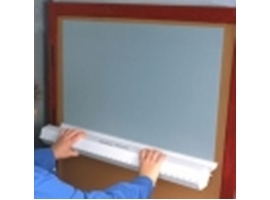How to Guide - Applying Capillex to large screens
Synopsis...
Applying Capillex to medium and large format screens is easy with the right technique
Applying Capillex to medium and large format screens (0.5m² - 1.5m²)
There are two main methods recommended for this format: (i) the traditional roll down method, or (ii) the use of the Caplicator. Method (ii) is now the preferred method as it helps to reduce the potential for dust entrapment, as the dust is wiped clean from the film surface immediately prior to adhering
To use the Caplicator simply roll the pre-cut sheet of film, emulsion side out, around the plastic core supplied with the unit. The roll can now be placed in the Caplicator, leaving a 2 cm leading edge proud of the lip.The film is then applied to a wet degreased screen that is held upright in the washout booth. See video below:
Which ever method is used, it is important to remove the excess water from the squeegee side immediately after the film as been applied to the mesh. Failure to do so can lead to an uneven stencil profile.
As with the small format application, both techniques benefit from the use a wet screen.
Tips for Perfect Stencils
The Caplicator can also be used as a simple film dispenser for measuring and cutting large sheets. Simply load the roll of film into the Caplicator, mark a position on the core supplied and then the film can be wound directly onto the core and cut using a safety knife. The length of film can easily be measured by counting off the number of core rotations needed to achieve the required film length.
Not only does this method reduce the potential for kinking the film, it also cuts down on dust contamination as the film surface does not come into contact with the table top.
Dust Reduction Method - The Semi Automatic Method
An alternative is to use Capillex Laminating Fluid instead of water to wet the screen prior to film application. Although this method does require the use of a dry screen, the laminating fluid is especially formulated to reduce the effects of ‘dust tenting’. Two coats of the laminating fluid are quickly applied to the squeegee side of the mesh. The film is then applied to the print side along with one more coat of the laminating fluid, which effectively squeegees of any excess fluid. The video below shows how simple this method is
An alternative method for applying large sheets of film, is the spray method. A light mist of water is first applied to a dry screen using a compressed air paint sprayer and then the film is unrolled onto the print side. The film can then be adhered fully by applying a further mist of water to the squeegee side. This method is best used in conjunction with a Caplicator.




